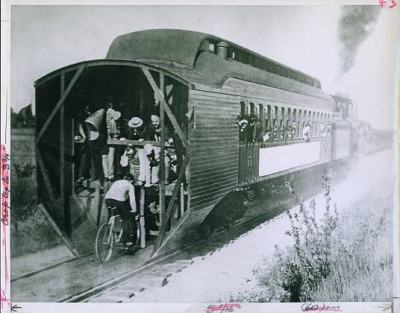 Back in 1899, Charles Minthron Murphy achieved the incredible feat of pedaling his bicycle one mile in a minute by drafting behind a speeding train.
Back in 1899, Charles Minthron Murphy achieved the incredible feat of pedaling his bicycle one mile in a minute by drafting behind a speeding train.
He's probably lucky that he wasn't killed. Since he survived the ordeal, he forever after became known as “Mile-a-Minute” Murphy.
Now the Town of Babylon, on New York's Long Island, would like to commemorate the event that happened there by putting Murphy's track bicycle on display.
The problem is that the bicycle is in storage at the Springfield (Massachusetts) Museums and they won't relinquish it, not even for the offer of $20,000 from Babylon.
Famous cyclist
At the time, Murphy's feat put Babylon on the map and celebrated human achievement.
Murphy was a famous cyclist of his day and was inducted into the US Bicycling Hall of Fame in 1991. Before he became “Mile-a-Minute”, Murphy was National Tandem Champion in 1891, won League of American Wheelman titles from 1 to 5 miles, set 17 national records, and broke seven world records in distances of up to 10 miles.
When he was about 30 years old, he boasted to some friends that he could keep up with a locomotive. They laughed, but he later said that he figured the locomotive would push aside the air and he could ride in the vacuum behind it.
He signed a deal with the Long Island Railroad, convincing them that the publicity would benefit their railroad as well.
They laid two miles of planks between the rails from Babylon to Farmington and built a partial enclosure on a railroad car behind the locomotive to shelter him and hold observers and some newspapermen.
With more than a thousand people lining the route, Murphy didn't achieve the mile-a-minute goal on the first few runs because the locomotive didn't go that fast. The regulator was turned off for the second attempt.
Here's how Murphy described it in his own words:
“Within five seconds the rate of speed was terrific; I was riding in a maelstrom of swirling dust, hot cinders, paper and other particles of matter. The whipsaw feeling through a veritable storm of fire became harder every second. I could feel myself getting weaker every second I saw ridicule, contempt, disgrace and a lifetime dream gone up in smoke. I saw the agonised faces, yelling, holding out stretched hands as if they would like to get hold of or assist me somehow. …
“Wobbling to and fro, but still gaining, the dust, the odour of burning rubber… The car was crowded with men who had been used to seeing any and all things that were dangerous, but the howling and screaming of sturdy officials and newspaper men from all over the United States that stood on the platform put all on edge. Suddenly, three-quarters was passed in 43 4/5 seconds. I expected to go off the track, travelling faster than the train, with the terrible storm of dust, pebbles, hot rubber and cinders. I looked up blankly. It was getting to a point where I could expect anything.”
As they neared the end of the planks, Murphy crashed into the back of the car, he grabbed a bar and was hoisted onboard, along with his bike. He had covered a mile in 57.8 seconds.
“Charles M. Murphy of Brooklyn yesterday drove a bicycle a mile faster than any human being ever before drove any kind of a machine and proved that human can, for a short distance at least, excel the best power of steam and steel and iron.”
Murphy later went onto to become a motorcycle policeman in New York City, where his police career came to an end in 1917 when he was struck by a car and his leg was broken in three places. He died in 1950 at age 79.
The bike
His bicycle, a Tribune “Blue Streak,” was on display in the 1970s at the Nassau County Museum. It later found its way into the Indian Motorcycle Museum in Massachusetts, which has been acquired by the Springfield Museums.
While a display of Indian and Harley-Davidson's motorbikes are on display in Springfield, the museum currently has the bicycle in storage.
See also the You Are the Engine and Prolly is not Probably blogs and Arrt's Arrchives.


Recent Comments